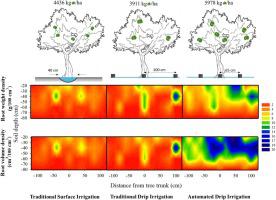Urban Forestry & Urban Greening ( IF 6.0 ) Pub Date : 2021-02-23 , DOI: 10.1016/j.ufug.2021.127053 Fahime Mohamadzade , Mahdi Gheysari , Mina Kiani

|
Water scarcity encourages municipalities to use more precise irrigation systems in arid urban landscapes. However, major concerns are associated with the adaptation of mature trees to new irrigation systems after they have matured under traditional management. We investigated the adaptation of mature olive trees to a change in irrigation system from a traditional surface to an automatic drip irrigation system in a coarse-textured urban forest park. The growth indices of eight-year-old olive trees were monitored for the period of 2012–2014 under three irrigation systems: (1) automated drip irrigation (ADI) for trees that matured under traditional basin-surface irrigation (TSI), (2) TSI since plantation, and (3) traditional drip irrigation (TDI) irrigating the trees depending on water availability since the time of planting. We additionally determined the spatial pattern of root development by collecting 156 soil samples from each irrigation system with a 20 × 20-cm grid system (120 cm width × 80 cm depth) in the soil profile. Results showed no significant differences in terms of fruit productivity between TSI and recently established ADI systems. Automated drip irrigation resulted in the maximum root density with a uniform root distribution pattern, where roots expanded all over the soil profile. In TSI, however, the roots were distributed irregularly, with the highest density close to the irrigation basin. The wide spacing between drippers in the TDI system created large gaps between the wetted zones in the soil with a low water-holding capacity, leading to a discrete small root system. The present study highlights the positive response of mature olive trees to the replacement of the irrigation system in an urban forest park with limited available water and low soil quality. Our findings will help municipalities to properly preserve mature urban trees and the ecosystem services for their inhabitants.
中文翻译:

城市树木的根系适应更精确的灌溉系统:以成熟橄榄为例
缺水鼓励市政当局在干旱的城市景观中使用更精确的灌溉系统。然而,主要问题与在传统管理下使成熟树木在成熟后适应新灌溉系统有关。我们研究了成熟橄榄树对灌溉系统的变化的适应性,该灌溉系统从传统表面转换为粗糙纹理的城市森林公园中的自动滴灌系统。在三种灌溉系统下监测了八年历史的橄榄树在2012–2014年期间的生长指数:(1)自动滴灌(ADI),用于在传统流域地表灌溉(TSI)下成熟的树木;(2 )自种植以来的TSI,以及(3)传统的滴灌(TDI)根据种植后的可用水量灌溉树木。我们还通过从每个灌溉系统收集了156个土壤样品,并利用20×20 cm网格系统(120 cm宽×80 cm深度)在土壤剖面中确定了根系发育的空间格局。结果表明,TSI和最近建立的ADI系统之间在水果生产率方面无显着差异。自动滴灌导致最大的根系密度,具有均匀的根系分布模式,其中根系遍布整个土壤剖面。然而,在TSI中,根系不规则地分布,密度最高的区域靠近灌水盆地。TDI系统中滴头之间的较大间距在土壤的湿润区域之间形成了较大的缝隙,而持水能力却很低,从而导致了离散的小根系。本研究强调了在可用水有限且土壤质量较差的城市森林公园中,成熟的橄榄树对灌溉系统替代的积极反应。我们的发现将有助于市政当局妥善保存成熟的城市树木和为其居民提供的生态系统服务。











































 京公网安备 11010802027423号
京公网安备 11010802027423号